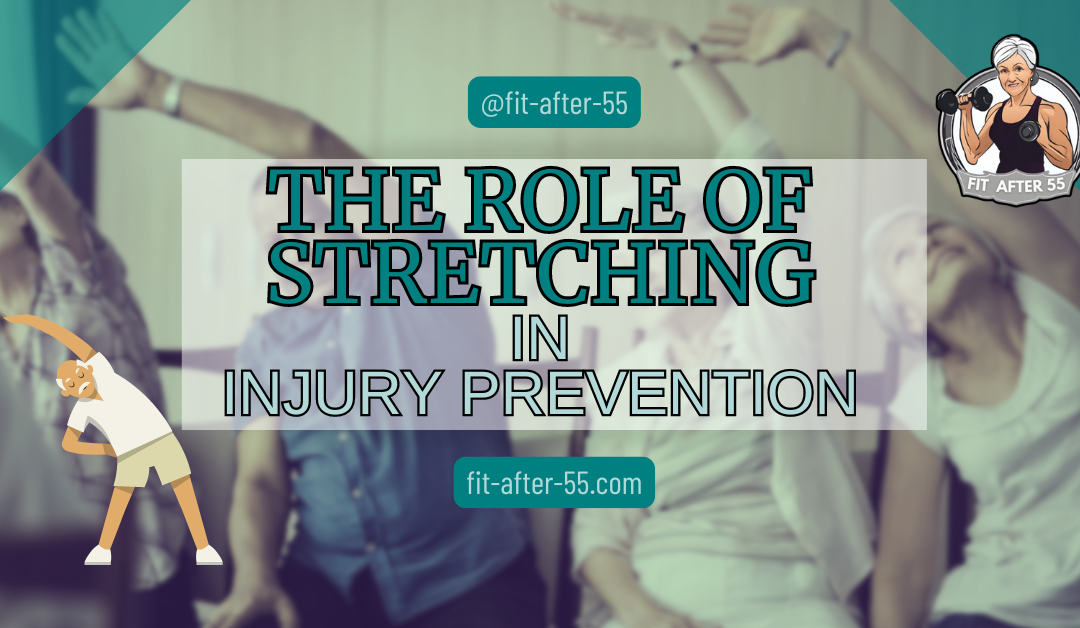Stretching in injury prevention is something I’ve come to appreciate as a senior. Those days of skipping warm-ups and cool-downs are long gone. Now, I understand that stretching isn’t just about feeling good; it’s a crucial component of preventing injuries and maintaining a healthy, active lifestyle.
Stretching in Injury Prevention: More Than Just a Warm-Up
I’m going to let you in on something fundamental. Stretching isn’t just a prelude to the main workout event or a quick habit to prevent muscle soreness. It’s about setting the stage for an injury-free fitness journey. Now, you might be picturing someone touching their toes or doing a butterfly stretch, but it’s more nuanced than that.
You’re going to find out about the various types of stretches – static, dynamic, ballistic, PNF – and don’t worry too much about those fancy terms; I’ll walk you through them. Each type has its place, depending on your activity, and can provide different benefits.

This isn’t just about stretching itself, it’s also about the reasons behind it. Some might say the goal is to become as flexible as a gymnast, but I think of it more as a way to communicate with your body. Understanding its limits and how to push them without crossing into injury territory is crucial.
Now what are those prevailing theories on how stretching might help avert those dreaded sprains and strains? We’ll dive into how a well-limed stretch can potentially save you from the vicious cycle of rest, rehab, and recovery that comes with injuries. So, let’s get ready to stretch our knowledge on this topic, and trust me, it’s going to be more exciting than it sounds.
Key Takeaways
- Stretching is essential for injury prevention: It’s not just about feeling good; stretching improves muscle flexibility and helps prevent strains and sprains.
- Different types of stretches have different benefits: Static, dynamic, ballistic, and PNF stretches each have their own advantages, depending on your activity and goals.
- Stretching is one part of a holistic approach to injury prevention: While stretching is important, it’s not enough on its own. A balanced approach that includes strength training, proper nutrition, rest, and overall fitness is crucial for preventing injuries.
Understanding How Stretching Affects the Muscles
Let’s talk about how stretching can truly transform your muscles. Put aside the ice packs and painkillers for a moment and think of stretching as a tune-up for your body. It’s not just about “feeling limber”—the real magic happens behind the scenes.

Why Stretching is More Than Just Flexibility
When you stretch, you’re elongating your muscle fibers, improving flexibility, and building your muscles’ ability to handle more physical stress. Every stretch you do is like upgrading your muscles’ software, teaching them to relax and lengthen a little more each time.
Immediate and Long-Term Benefits of Stretching
Stretching offers both immediate and long-term benefits. While you might feel more flexible right away, the real treasure lies in the long-term gains. Consistent, mindful stretching increases your range of motion, which can lead to a more pain-free life over time.
The Power of Circulation: An Overlooked Benefit
One often overlooked benefit is the boost in circulation that stretching provides. It’s like sending a rush of blood and nutrients to your muscles, essential for repair and growth. And this isn’t a one-time thing—keep stretching regularly, and you’ll keep that steady supply of nourishment flowing to your muscles.
Now that you know the perks, let’s dive into the evidence. How can we be sure stretching isn’t just a fitness fad? Science has some fascinating insights, and I can’t wait to share what the research says.
Evidence-Based Insights: Stretching and Injury Risk Reduction
Let’s dive into an important topic: what science says about stretching. When it comes to preventing injuries, we need to move past personal stories and focus on evidence-based research. Numerous studies have explored how regular stretching affects injury risk, and the findings are pretty interesting.
First, it’s crucial to understand the difference between correlation and causation when reviewing research. Some studies suggest that dynamic stretching—where movements mimic the activity you’re preparing for—can reduce injury risk, especially when it’s tailored to the specific demands of a sport or exercise.

However, not all research agrees on how much stretching alone can prevent injuries. Sports science is evolving quickly, and new studies are constantly emerging that may offer more clarity. What’s clear is that consistency is key—irregular stretching doesn’t seem to provide the same protective benefits.
It’s important to clear up a common misconception: stretching isn’t a cure-all for injury prevention. While it plays a role, it’s just one part of the equation. A well-rounded injury prevention plan should include stretching alongside other strategies, which I’ll discuss in the next section.
Incorporating Stretching into Your Routine Safely will be your guide to implementing these insights. You’ll learn how to add stretching to your daily routine and workout schedule without overdoing it. Every body is different, so it’s about finding the right balance to prevent injury and support overall muscle health.
Incorporating Stretching into Your Routine Safely
Let’s walk through how you can make stretching a safe and beneficial part of your daily routine. It’s not just about bending and twisting—there’s a right way to do it. I’ll show you the best methods, when to stretch, and how to avoid common mistakes that could lead to injury.

The Importance of Timing and Technique
When it comes to stretching before and after physical activity, timing and technique are key. Before a workout, prioritize dynamic stretches to get your muscles and joints ready for movement. After your workout, focus on static stretches to help with recovery and improve flexibility. The golden rule? Avoid bouncing, and always stretch within a comfortable range—never push to the point of pain.
Listen to Your Body: Safety Comes First
Safety comes first, and there’s no need to aim for being the most flexible person around. The goal is to stretch gradually. Over time, you can increase the length and intensity of your stretches, but always pay attention to your body. Sharp pain is a clear signal to stop—that’s your body telling you, “too much!”
Customize Your Stretching to Your Needs
Your stretching routine should be tailored to your needs. Whether you’re an athlete or spend most of your day sitting, focus on stretching the muscles you use the most. Make it personal and aligned with your fitness goals.
Don’t stress about perfecting your routine from day one. You can always adjust it as you go. Stay consistent, and you’ll gradually notice improvements in your flexibility and a reduced risk of injury over time.
Holistic Injury Prevention: More Than Just Stretching
You might think stretching is the ultimate key to preventing injuries, but it’s important to remember that it’s just one piece of the puzzle. To truly protect yourself, you need to take a broader, more holistic approach. Injury prevention involves not just physical practices but also behavioral and lifestyle factors, all working together.

| Details | |
|---|---|
| Strength Training | Think of strength training as a major player in injury prevention. It’s not just about flexibility—your muscles need to be strong too. Adding resistance exercises helps build stronger muscles, which support your joints and reduce the risk of strains and sprains. |
| Nutrition | If strength training is the foundation, nutrition is the glue that holds everything together. Proper nutrients like protein, vitamins, and minerals are crucial for muscle repair and growth. Staying hydrated is also key to preventing cramping and fatigue, which can lead to injuries. |
| Warm-ups & Cool-downs | Warm-ups are essential for getting your heart rate up and preparing your muscles for activity. After your workout, cool-downs help with recovery and bring your body back to a resting state. |
| Rest Days | Rest days are more than just breaks—they’re necessary for recovery and rebuilding. Skipping them can lead to overtraining, which increases your risk of injury. Make sure to respect their importance in your routine. |
By embracing this holistic approach, you’re not only preventing injuries but also improving your overall well-being. It’s not just about being flexible—it’s about being strong, well-nourished, and smart about what your body needs.
Final Thoughts: Balancing Stretching with Overall Fitness
You’re going to find out that stretching, while valuable, isn’t the sole guardian against injury. Instead, it’s a single piece of a larger puzzle. This puzzle includes a mix of strength training, regular physical activity, proper nutrition, and adequate rest.
Choose something that resonates with you in terms of fitness and make stretching a part of it, rather than the entire focus. For some, this may mean a yoga class that emphasizes flexibility and mindfulness. For others, it could be dynamic stretches woven into a soccer warm-up routine.

Your first attempt at tuning your stretching routine doesn’t need to be your last. As your body changes with age, activity level, and fitness goals, so too should your approach to stretching. It’s an adaptable practice that can be tailored and refined over time.
Don’t focus too much on perfection. Instead, aim for consistency and listen to your body. It’s the best indicator of what you need. And remember, if you want to diminish the risk of injury, place equal importance on all aspects of a healthy lifestyle.
I really hope that you’ve found this deep dive into stretching and its role in injury prevention useful. It’s my aim to provide you with knowledge that not only informs but also empowers you to make the best decisions for your body.
So, hold on to the information shared, adjust your approach as necessary, and keep moving forward on your journey to better health. Thanks for sticking with me through this conversation, and I’d love to hear any feedback you have on the topic!
Frequently Asked Questions
Is it better to stretch before or after a workout?
While both pre and post-workout stretching have their benefits, most experts recommend dynamic stretching before a workout to warm up the muscles and prepare them for activity. Static stretching is often more effective after a workout to aid in recovery and improve flexibility.
How often should I stretch?
Aim for stretching most days of the week. Consistency is key. However, listen to your body and avoid overstretching, as it can lead to injury.
Can stretching alone prevent all injuries?
Stretching is a valuable tool for injury prevention, but it’s not a guarantee. A holistic approach that includes strength training, proper nutrition, adequate rest, and good form during physical activity is essential for minimizing the risk of injuries.
Don’t Just Stretch Your Way to Fitness!
Staying active after 55 is about more than avoiding injuries (although stretching definitely helps!).
Ready to unlock a world of fitness tips, product reviews, and a supportive community?
Head over to our website, Fit After 55, and join our Facebook group (link to Facebook page) to connect with like-minded individuals on their fitness journeys!
Together, let’s move with confidence and keep exploring the possibilities of an active life!

